Summary
The entry modes of Semliki Forest virus and Japanese encephalitis virus into C6/36 cells were compared by electron microscopic observation. At physiological pH, the two viruses showed characteristically different entry modes. Following attachment to the plasma membrane, many SF virions appeared within plasma membrane invaginations and cytoplasmic vesicles; on the other hand, JE virions remained to be found exclusively at the cell surface, with no virions appearing within cytoplasmic vesicles. Electron microscopic observation, therefore, indicated that SF virus entered C6/36 cells by receptormediated endocytosis, while JE virus penetrated the cells at the surface and disintegrated at or near the adsorption sites. At pH 5.8, SF virus also entered C6/36 cells by direct penetration at the cell surface. On the basis of the present and other findings, the following working hypotheses are presented for future investigations: (a) at physiological pH, the fusion protein of SF virus is in an inactive state and needs to be activated by acidic pH within the endosome in order to act on the host-cell membrane, but that of JE virus is in an active state and is capable of dissolving the host plasma membrane at the cell surface immediately after the attachment; (b) the states of viral fusion proteins (inactive or active) at the time of viral attachment to the cell surface determine which of the two entry modes these viruses follow.
Similar content being viewed by others
References
Borsa J, Morash BD, Sargent MD, Copps TP, Lievaart PA, Szekely JG (1979) Two modes of entry of reovirus particles into L cells. J Gen Virol 45: 161–170
Brodsky FM (1988) Living with clathrin: its role in intracellular membrane traffic. Science 242: 1396–1402
Cecilia D, Gadkari DA, Kedarnath N, Ghosh SN (1988) Epitope mapping of Japanese encephalitis virus envelope protein using monoclonal antibodies against an Indian strain. J Gen Virol 69: 2741–2747
Dales S (1965) Penetration of animal viruses into cells. Prog Med Virol 7: 1–43
Dales S (1973) Early events in cell-animal virus interactions. Bacteriol Rev 37: 103–135
Fuller AO, Spear PG (1987) Anti-glycoprotein D antibodies that permit adsorption but block infection by herpes simplex virus 1 prevent virion-cell fusion at the cell surface. Proc Natl Acad Sci USA 84: 5454–5458
Garoff H, Frischauf AM, Simons K, Lehrach H, Delius H (1980) Nucleotide sequence of cDNA coding for Semliki Forest virus membrane glycoproteins. Nature 288: 236–241
Garoff H, Kondor-Koch CL, Riedel H (1982) Structure and assembly of alpha viruses. Curr Top Microbiol Immunol 99: 1–50
Gollins SW, Porterfield JS (1985) Flavivirus infection enhancement in macrophages: an electron microscopic study of viral cellular entry. J Gen Virol 66: 1969–1982
Hase T, Summers PL, Eckels KH (1989) Flavivirus entry into cultured mosquito cells and human peripheral blood monocytes. Arch Virol 104: 129–143
Hase T, Summers PL, Eckels KH, Putnak JR (1989) Flavivirus morphogenesis. In: Harris JR (ed) Virally infected cells. Plenum, New York, pp 275–305 (Subcellular biochemistry, vol 15)
Helenius A, Kartenbeck J, Simons K, Fries E (1980) On the entry of Semliki Forest virus into BHK-21 cells. J Cell Biol 84: 404–420
Ishak R, Tovey DG, Howard T (1988) Morphogenesis of yellow fever virus 17 D in infected cell cultures. J Gen Virol 69: 325–335
Kielian M, Helenius A (1985) pH induced alterations in the fusogenic spike protein of Semliki Forest virus. J Cell Biol 101: 2284–2291
Kimura T, Gollins SW, Porterfield JS (1986) The effect of pH on the early infection of West Nile virus with P 388 D 1 cells. J Gen Virol 67: 2423–2433
Marsh M, Helenius A (1980) Adsorptive endocytosis of Semliki Forest virus. J Mol Biol 142: 439–454
Morgan C, Howe C (1968) Structure and development of viruses as observed in the electron microscope. VIII. Entry of influenza virus. J Virol 2: 925–936
Morgan C, Howe C (1968) Structure and development of viruses as observed in the electron microscope. IX. Entry of parainfluenza I (Sendai) virus. J Virol 2: 1122–1132
Morgan C, Rose HM, Mednis B (1968) Electron microscopy of herpes simplex virus. I. Entry. J. Virol 2: 507–516
Morgan C, Rosenkranz HS, Mednis B (1969) Structure and development of viruses as observed in the electron microscope. X. Entry and uncoating of adenovirus. J Virol 4: 777–796
Omar A, Koblet H (1988) Semliki Forest virus particles containing only the E1 envelope glycoprotein are infectious and can induce cell-cell fusion. Virology 166: 17–23
Omar A, Koblet H (1989) The use of sulfite to study the membrane fusion induced by E1 of Semliki Forest virus. Virology 168: 177–179
Ng ML, Lau CL (1988) Possible involvement of receptors in the entry of Kunjin virus into Vero cells. Arch Virol 100: 199–211
Summers PL, Cohen WH, Ruiz MM, Hase T, Eckels KH (1989) Flaviviruses cause fusion from without inAedes albopictus mosquito cell cultures. Virus Res 12: 383–392
Suzuki H, Kitaoka S, Konno T, Sato T, Ishida N (1985) Two modes of human rotavirus entry into MA 104 cells. Arch Virol 85: 25–34
Suzuki H, Kitaoka T, Sato T, Konno T, Iwasaki Y, Numazaki Y, Ishida N (1986) Further investigation on the mode of entry of human rotavirus into cells. Arch Virol 91:135–144
Vogel RH, Provencher SW, von Bonsdorff CH, Adrian M, Dubochet J (1986) Envelope structure of Semliki Forest virus reconstructed from cryo-electron micrographs. Nature 320: 533–535
Wengler G, Wengler G, Nowak T, Wahn K (1987) Analysis of the influence of proteolytic cleavage on the structural organization of the surface of the West Nile flavirvirus leads to the isolation of a protease-resistant E protein oligomer from the surface. Virology 160: 210–219
White J, Helenius A (1980) pH-dependent fusion between the Semliki Forest virus membrane and liposomes. Proc Natl Acad Sci USA 77: 3273–3277
White J, Kartenbeck J, Helenius A (1980) Fusion of Semliki Forest virus with the plasma membrane can be induced by low pH. J Cell Biol 87: 264–272
White J, Kielian M, Helenius A (1983) Membrane fusion proteins of enveloped animal viruses. Q Rev Biophys 16: 151–195
White J, Matlin K, Helenius A (1981) Cell fusion by Semliki Forest, influenza, and vesicular stomatitis viruses. J Cell Biol 89: 674–679
Author information
Authors and Affiliations
Rights and permissions
About this article
Cite this article
Hase, T., Summers, P.L. & Cohen, W.H. A comparative study of entry modes into C6/36 cells by Semliki Forest and Japanese encephalitis viruses. Archives of Virology 108, 101–114 (1989). https://doi.org/10.1007/BF01313747
Received:
Accepted:
Issue Date:
DOI: https://doi.org/10.1007/BF01313747




